The content of the article
- 1 What does a reptile look like?
- 2 Snake's habitat
- 3 Reptile distribution area
- 4 Peculiar behavior of the reptile
- 5 Subpopulations of reptile
- 6 How do reptiles get their food?
- 7 Who is wary of the snake?
- 8 Is it possible to make a reptile pet?
- 9 How to equip a terrarium for reptiles?
- 10 What does a snake eat?
- 11 Do I need to take precautions?
- 12 Reptile Health
- 13 How to breed snakes at home?
- 14 Recommendations for the purchase of corn snake
- 15 Video: Corn Snake (Pantherophis guttatus)
Maize snake is one of the most prominent representatives of the genus Pantherophis. It follows from the fact of its belonging to the family of morphuses that the representatives of this species are not poisonous. There is another unofficial name for the reptile "red rat snake". The reason for his appearance was the unusual appearance of the animal. This name is not limited to the snake. It is known that if such an individual enters the collection of exotic animals, the owners call it a guatata.
What does a reptile look like?
The maximum length of an adult individual is 2 m.Typically, the average runner reaches 1.5 m. Today, scientists have recorded a large number of varieties of the runner, in particular, differing from each other in skin color. Despite this, it is generally recognized that the main color of reptiles is a bright orange background, which is decorated with coal-black stripes, in turn, covered with motley red spots on both sides. The abdomen of the snake is decorated with a pattern resembling a geometric pattern: the reptile pattern is black and white.
Snake's habitat
In most cases, the corn snake is predominantly an earth dweller. But this is not the only reason that it is limited and deftly mixed up along the trunks and branches of trees, as well as in the midst of bushes.
Interesting fact!
The origin of the second name of the corn snake is due to the people by the frequent presence of a snake near the granaries and extensive corn plantations. These places attract the reptile a large number of rodents, which he often hunt. However, there is another version based on the assumption that the pattern adorning the reptile's belly,very much like the pattern that makes up the corn cob.
Reptile distribution area
In the natural habitat of the corn snake, you can often meet in the territory of forests where deciduous trees grow. In addition, the snake quickly settles barren land, located next to the rocks. The territory of the Mexican villages and the Cayman Islands are famous for huge populations of snakes of this species. A particularly large number of individuals lives near farms and village farms.
Peculiar behavior of the reptile
In the wild, the snake lives on earth for about 4 months. After that, it is usually mixed up on trees, shrubs and other hills, in the role of which can also be cliffs and rocks. Adult individuals often lead to a half-woody, half-earthen lifestyle.
Subpopulations of reptile
The Maisopus is characterized by a large number of subspecies, the distinctive features of which are the extraordinary color of reptiles. Such subspecies in biology are called morphs. Consider the most famous examples.
- If the reptile does not have a black color, then it is most likely to be attributed to a morph called Amelanism. The snake skin of this subpopulation is colored light pink or red.
- A subpopulation of Hypomelanism is represented by snakes whose body is covered with polynomial scales of brown and gray shades.
- The lack or absence of a yellow pigment are the hallmarks of the snake morph called Charcoal. The individuals of this subspecies have a color in which gray and brown colors and their shades prevail.
- Reptiles with a mutation that eliminates the red color by replacing it with the numerous yellow shades that are dominant in the coloring of the snake's skin, belong to the morph. Caramel.
- Reptiles of the “Lava” subspecies are black-dominated snakes, often resulting in totally black skin with light patches of light shades.
- Lack of melanin is the calling card of representatives of the Lavender subpopulation. Such an unusual mutation leads to an inimitable natural color that varies from pink to purple hues.
How do reptiles get their food?
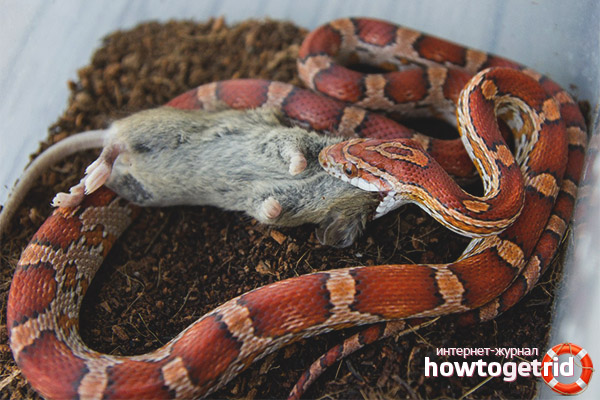
Snake hunting time is in the evening or deep night. It is during this period that the snake has a huge advantage - it sees the goal perfectly, which means it achieves it more successfully. Who are the victims of reptiles? The ration of a snake includes numerous rodents, such as mice and rats, as well as birds and their offspring, bats.
Who is wary of the snake?
The greatest enemy of the corn snake is such birds, as storks and herons, kites, hawks and eagles. Mammals also become a threat to this species of ape. So, the red rat snake should be wary of wild boars, leopards, jaguars, crocodiles.
Is it possible to make a reptile pet?
Nowadays, the practice of “domestication” of wild runners is widespread. Medium-sized individuals, whose character is devoid of tendency to aggression, are suitable for this activity. The process of keeping snakes in the home is not a big difficulty. On the contrary, snakes of this species are unpretentious in many matters, which makes life much easier for the owners. However, this fact does not negate the importance of adhering to the basic rules to ensure the necessary conditions for the existence of the pet.
How to equip a terrarium for reptiles?
In order to choose the right terrarium, you need to pay attention to the size of the reptile and its age. The maintenance of young individuals requires a "house", the volume of which is equal to 40-50 liters. An adult formed runner must be defined in a terrarium, the size of which is 70 cm in length, 40 cm in height, and 40 cm in depth. The volume of such a “dwelling” can reach 100 liters. The filler of an aquarium is often chips of coniferous trees, for example, pine. In addition, bark, peeled gravel and ordinary paper are often used. Biologists recommend maintaining terrarium lighting with fluorescent lamps.
Pay attention to the fact that a corner with a warm temperature reaching 20-30 ° C and a cold temperature of about 25 ° C must be equipped in the “home” of the reptile. At night, the temperature should not rise above 23 ° C and fall below 21 ° C. Stabilization of the humidity regime is provided by a spray gun that sprays terrarium space with water at room temperature. What else should be in the terrarium? Firstly, a large drinking bowl, and secondly - peeled fragments of roots and snags.
What does a snake eat?
Feeding adults should occur every week. The rat, mouse and chickens are small in size. In order to avoid pet injuries, it is better to use not live, but killed frozen animals. Before serving, feed must be thawed. The basis of reptile nutrition should include vitamins and minerals in the form of biological additives. Do not forget to regularly change the water, as it must always be clean and fresh.
Do I need to take precautions?
One of the most frequently asked questions is the following - is the maize snake poisonous, and what consequences follow its bite? The answer to it will please many, because the red rat snake is not poisonous, which means it cannot harm people and other pets.
Interesting fact!
The corn snake is very similar to the poisonous snake, which is called the copper-headed shtekomordnik. These species are very easily confused. However, the differences still exist. One of them is the constricted head of individuals of the second named species, as well as the presence of spots in the color, which have the shape of a square.
Reptile Health
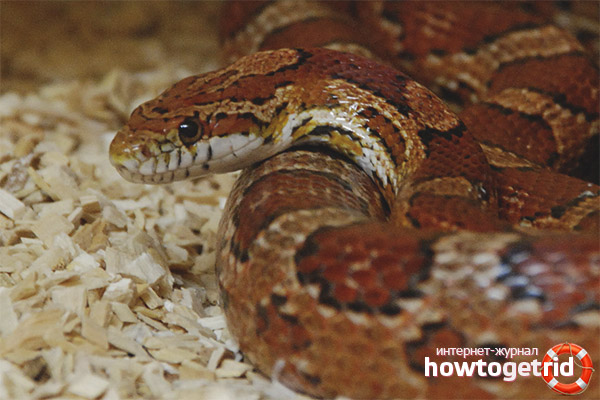
A large number of snakes, which were born in "captivity", that is, at home, had health problems. This fact is a negative consequence of the growing practice of breeding snakes at home. Among the identified difficulties, death without a cause is most often noted and a sharp decrease in the lifetime. There are cases when reptiles, due to friction on the terrarium, receive wounds that need to be treated and treated with disinfectants or antibiotic drugs. If you keep an individual, without neglecting the important rules, its life span can reach 10 years.
How to breed snakes at home?
For breeding offspring in an unnatural habitat, it is worth using females that have reached the age of three, and males at the age of two years. The length of the female should be approximately 1 m, weight - 0.4 kg. It is possible to stimulate the process of reproduction through artificial hibernation during the winter period, which should last about 2 months. For this purpose, a necessary regime is created, the temperature in which does not exceed 13 ° C.
Interesting fact! Representatives of the latter-day offspring have a tooth that helps them get out of the egg without help.
Recommendations for the purchase of corn snake
To purchase a reptile of this species today does not present great difficulties. The unpretentious nature of the beloved red rat snake has become one of the main reasons for their widespread occurrence among people interested in exotic animals. A large number of razvodchikov is engaged in his cultivation and cultivation in house conditions.Before purchasing a pet, pay attention to the degree of cleanliness of its skin, on which there should be no cracks and parasites. The eyes of a healthy reptile are usually clear, the body is fed. Do not be lazy to learn about the origin of the reptile, since the conditions of its content depend on the birth of the snake. Usually, snakes, which were born in “captivity”, take root more easily.
Video: Corn Snake (Pantherophis guttatus)

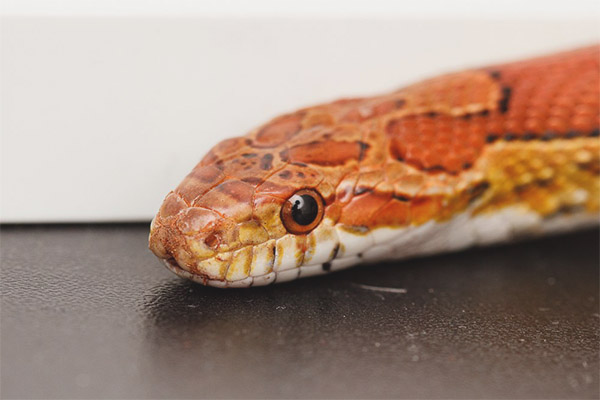

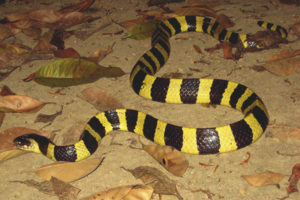

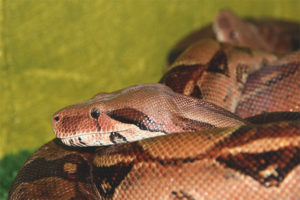
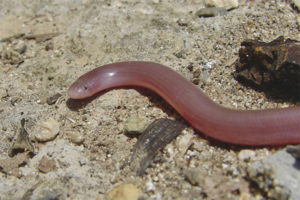
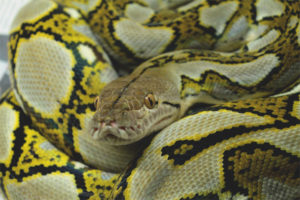
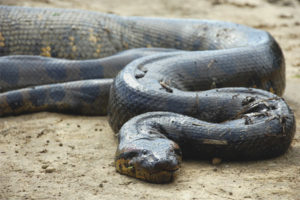
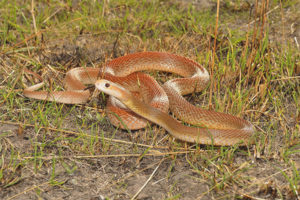
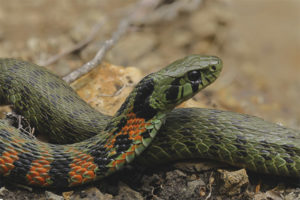
To send